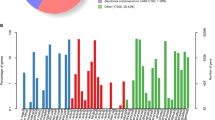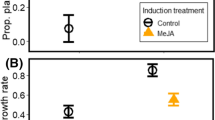Abstract
Specialist herbivores are known to alter their host's wound-induced responses but the beneficiaries of these alterations are unknown. Nicotiana attenuata plants release a burst of ethylene specifically in response to feeding by Manduca sexta larvae, which is known to suppress wound- and methyl jasmonate (MeJA)-inducible nicotine accumulation. The ethylene burst may be a mechanism by which M. sexta larvae feed "stealthily" on their host plants or, alternatively, it may allow the plant to optimize its defense response against this specialist herbivore by reducing costs of induction. We examined the impact of the ethylene burst on defense-related fitness costs that are readily observed when plants are treated with MeJA and grown in competition with untreated plants. We elicited nicotine induction (with MeJA), the ethylene burst (with the ethylene releasing compound, ethephon) and inhibited the plant's ability to perceive ethylene (with applications of an antagonist of ethylene receptors, 1-methylcyclopropene, 1-MCP). By simultaneously applying MeJA and ethephon we mimicked the plant's hormonal response to larval attack. We hypothesized that if the ethylene burst benefited the plant, the fitness costs of MeJA induction should be reduced by ethephon and restored if the plants were additionally treated with 1-MCP. In a second experiment, we applied larval oral secretion (OS) to elicit endogenous hormone production and predicted that the 1-MCP treatment should reduce the fitness of OS-treated plants. Our measures of plant fitness, namely the rate of stalk elongation and lifetime capsule production, supported these predictions. We conclude that the ethylene burst elicited by this specialist herbivore can reduce MeJA-induced fitness costs and increase the competitive strength of OS-treated plants. Suppressed nicotine production is likely to contribute to, but is not sufficient to explain, the observed fitness outcomes. The intensity of intra-specific competition and herbivore attack will likely determine the adaptive value of the M. sexta-elicited ethylene response.
Similar content being viewed by others
Author information
Authors and Affiliations
Additional information
Electronic Publication
Rights and permissions
About this article
Cite this article
Voelckel, C., Schittko, U. & Baldwin, I. Herbivore-induced ethylene burst reduces fitness costs of jasmonate- and oral secretion-induced defenses in Nicotiana attenuata . Oecologia 127, 274–280 (2001). https://doi.org/10.1007/s004420000581
Received:
Accepted:
Published:
Issue Date:
DOI: https://doi.org/10.1007/s004420000581




